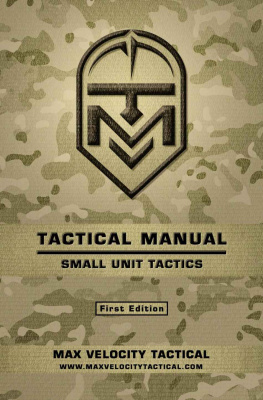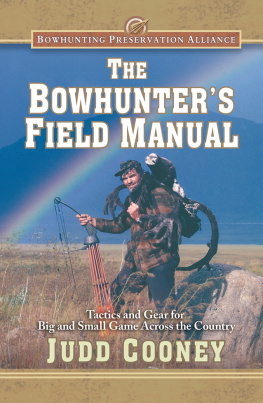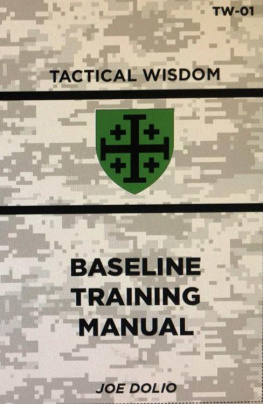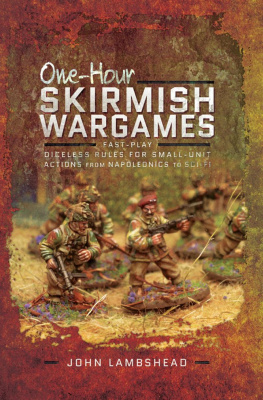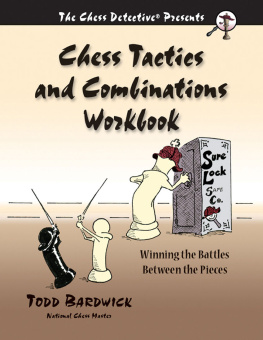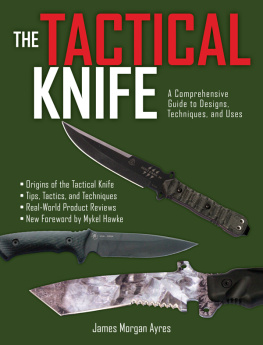Max Alexander - Tactical Manual: Small Unit Tactics
Here you can read online Max Alexander - Tactical Manual: Small Unit Tactics full text of the book (entire story) in english for free. Download pdf and epub, get meaning, cover and reviews about this ebook. year: 2018, genre: Home and family. Description of the work, (preface) as well as reviews are available. Best literature library LitArk.com created for fans of good reading and offers a wide selection of genres:
Romance novel
Science fiction
Adventure
Detective
Science
History
Home and family
Prose
Art
Politics
Computer
Non-fiction
Religion
Business
Children
Humor
Choose a favorite category and find really read worthwhile books. Enjoy immersion in the world of imagination, feel the emotions of the characters or learn something new for yourself, make an fascinating discovery.
- Book:Tactical Manual: Small Unit Tactics
- Author:
- Genre:
- Year:2018
- Rating:4 / 5
- Favourites:Add to favourites
- Your mark:
- 80
- 1
- 2
- 3
- 4
- 5
Tactical Manual: Small Unit Tactics: summary, description and annotation
We offer to read an annotation, description, summary or preface (depends on what the author of the book "Tactical Manual: Small Unit Tactics" wrote himself). If you haven't found the necessary information about the book — write in the comments, we will try to find it.
Tactical Manual: Small Unit Tactics — read online for free the complete book (whole text) full work
Below is the text of the book, divided by pages. System saving the place of the last page read, allows you to conveniently read the book "Tactical Manual: Small Unit Tactics" online for free, without having to search again every time where you left off. Put a bookmark, and you can go to the page where you finished reading at any time.
Font size:
Interval:
Bookmark:

TACTICAL MANUAL
Small Unit Tactics
First Edition
MAX VELOCITY TACTICAL
www.maxvelocitytactical.com
Website: www.maxvelocitytactical.com
Email: maxvelocitytactical@gmail.com
Copyright 2018 by Max Velocity Tactical
All rights reserved.
ISBN-13: 978-1536876000
ISBN-10: 1536876003
This Tactical Manual (TM) is intended for training and operations for small tactical units. The TM utilizes several sources, including United States and British Army doctrine, mixed with training and operational best practices and lessons learned.
This TM is designed to support training and operations primarily for tactical elements no larger than platoon / troop strength. The TTPs laid out are ideal for special operations, light infantry and paramilitary tactical organizations. Accordingly, the TM focuses on squad and team operations. It does not focus on specific weapon systems, but rather on tactical principles utilizing generic direct fire small arms. Organizations with heavier support and indirect fire weapon systems will incorporate those in line with the tactical principles. This TM by itself will not act as a substitute for effective team training. It is designed to support training and subsequent operational activities.
Max Velocity Tactical offers live fire and force on force tactical training. Details at the website:
www.maxvelocitytactical.com
Max Velocity Tactical (MVT) operates the Velocity Training Center (VTC) tactical and leadership training facility near to Romney, West Virginia, where we provide training for US Special Operations Forces and Responsible Citizens. MVT has established a reputation on the leading edge of tactical live fire and force on force training. At MVT we are dedicated to developing and training tactical excellence.
CONTENTS
This initial chapter outlines basic field-craft and weapon handling skills that should be mastered as a building block for effective application of small unit tactics in the field.
Individual Factors:
Personal Discipline.
Tactical Awareness.
Professional Posture.
Alert & Physically Fit.
Fire positions when halted.
Light & Noise discipline.
Tactical common sense.
Battle Preparation :
S ecurity ensure 360 security is maintained.
A mmunition distribute, load in magazines.
W eapons clean / lubricated. Function test. Test fire if possible.
P ersonal Camouflage/clothing appropriate to the operation.
E quipment ensure you have it all and it is squared away.
R adios batteries, frequencies, call-signs, radio check.
S pecial Equipment tailored to the operation i.e. wire cutters.
O rders Team Leader briefs on the operation.
= SAWPERSO
Observation:
Scan allotted sector.
Left, center, right, near, middle, far. 'S'-shape scan pattern.
Look through foliage, not at it.
Natural night vision:
Takes time to develop.
Protect it from white light.
Observe slightly to the side of the object.
Consider the use of Thermal Imaging (FLIR) Devices for scanning. Use only one eye in order to protect natural night vision in the other.
Why Things are Seen:
Shape - obvious non-natural shape of object.
Shine:
- reflect from non-natural surface.
- i.e. sweat shine on face - use cam stick.
Shadow:
- use shadows for concealment positions.
- Ensure shadow is not cast out of concealment.
Surface - non-natural surface.
Silhouette:
- sky-lining by day or night.
- lack of suitable background
Spacing:
- Nature does not provide exact spacing.
- break up patrol intervals, not exact distances.
Movement:
- Most obvious thing that catches the eye.
- Observe slowly, move eyes and head slowly.
- Avoid rapid 'bird' head movements.
- Slow steady movement when on patrol.
Muzzle Flash:
- Day / night considerations.
- Without Night Vision, at night fire can be retuned at muzzle flash.
- Muzzle blast will also kick up sand/ dirt.
- Use standard birdcage / suppressor to reduce muzzle signature.
- Do not use muzzle brakes.
Aircraft:
- do not look up at passing aircraft.
- Consider concealment from aircraft as well as ground observation
Thermal Imaging: Counter with:
- Terrain & Vegetation masking.
Camouflage:
- Camouflage pattern or drab / earth tone colored clothing and equipment suitable to the terrain.
- Consider clothing appropriate to the operating environment i.e. posture / profile considerations.
- Using Foliage:
- Lay leaves the right way up.
- Dont use too much.
- Replace dying foliage.
- Change foliage when you change type of terrain.
- Use foliage to break up the pattern of head/shoulders/helmet.
- You will need to utilize elastic cord sewn into your equipment and hat/helmet straps to effectively use foliage.
- Camouflage Paint:
- Rural Operations: face, hands and wrists (exposed parts).
- Not too much, not too little, just right.
Judging Distances :
There are two main methods of judging distance without aids:
- Unit of measure
- The appearance method
The Unit of Measure Method: To use this method, visualize a known distance on the ground and calculate how many of the units would fit between the observer and the object. An easy figure to use is a unit of 100 meters or yards. This method gives acceptable results when:
- The observer can see all the intervening ground; and
- The distance to be estimated is not greater than 400m.
The Appearance Method: This is based on what an object looks like compared to its surroundings. To become proficient in judging distances by this method a great deal of practice is required, under varying conditions of ground and observation. The amount of visible detail of a person at various ranges gives a good indication of the distance he is away. An observer with good vision should be able to distinguish the following detail in a person:
- 100 m: clear in all detail.
- 200 m: clear in all detail, color of skin and equipment identifiable.
- 300 m: clear body outline, face color good remaining detail blurred.
- 400 m: body outline clear, remaining detail blurred.
- 500 m: body begins to taper, head becomes indistinct.
- 600 m: body now wedge shape, no head apparent.
Conditions that affect the appearance of objects are as follows:
Objects are closer than they appear when:
- the light is bright, or the sun is shining from behind the observer.
- They are large in comparison with the surroundings.
- There is dead ground between the object and the observer; or
- They are higher up than the observer.
Objects are farther than they appear when:
- The light is bad, or the sun is shining in the observers eyes.
- They are small in comparison with the surroundings.
- Looking across a valley or down a road or track; or
- The observer is lying down.
Aids to Judging Distance:
- Bracketing: the method most likely to prove the best under all conditions. The observer should decide on the furthermost possible distance and the nearest possible distance to the object. The average of these is taken as the range. For example, if the furthest estimated distance is 1000 m and the nearest distance is 600 m then the range is therefore 800 m.
- Halving: this method is useful for judging distance up to 1000 m. The observer estimates the distance to a point half-way and in a direct line to the object he then doubles it. The main disadvantage of this method is that any error made in judging the distance to the halfway point is doubled for the full distance.
Font size:
Interval:
Bookmark:
Similar books «Tactical Manual: Small Unit Tactics»
Look at similar books to Tactical Manual: Small Unit Tactics. We have selected literature similar in name and meaning in the hope of providing readers with more options to find new, interesting, not yet read works.
Discussion, reviews of the book Tactical Manual: Small Unit Tactics and just readers' own opinions. Leave your comments, write what you think about the work, its meaning or the main characters. Specify what exactly you liked and what you didn't like, and why you think so.

